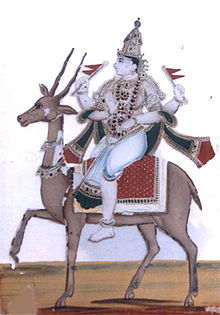Thanjavur painting is a classical South Indian painting style, which was inaugurated from the town of Thanjavur and spread across the adjoining and geographically contiguous Tamil country. The art form draws its immediate resources and inspiration from way back about 1600 AD, a period when the Nayakas of Thanjavur under the suzerainty of the Vijayanagara Rayas encouraged art—chiefly, classical dance and music—as well as literature, both in Telugu and Tamil and painting of chiefly Hindu religious subjects in temples. However, it can safely be surmised that Thanjavur painting, as we know it now, originated in the Maratha court of Thanjavur (1676 – 1855). It has been recognized as a Geographical indication by the Government of India in 2007-08.
Thanjavur paintings are characterised by rich, flat and vivid colors, simple iconic composition, glittering gold foils overlaid on delicate but extensive gesso work and inlay of glass beads and pieces or very rarely precious and semi-precious gems. In Thanjavur paintings one can see the influence of Deccani, Vijayanagar, Maratha and even European or Company styles of painting. Essentially serving as devotional icons, the subjects of most paintings are Hindu gods, goddesses, and saints.
Stone Carving

Woodcraft

Pattamadai mats

Kanchipuram Saris

Chola Bronzes

Papier Mache

Musical Instruments

Bharata Natyam
Bharata Natyam is a form of Indian classical dance that originated in the temples of Tamil Nadu. Bharata Natyam, like other classical dance forms in India, traces its origin to the Natya Shastra, a foundational treatise on the performing arts, it further developed into its own distinct style during 3rd century BCE to c. 4th century CE in ancient Tamilakam.









